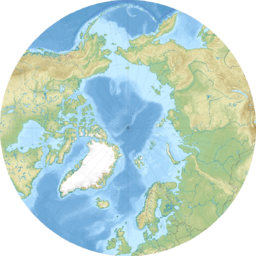This article needs additional citations for verification. (January 2012) |
| Kara Sea | |
|---|---|
 Map showing the location of the Kara Sea. | |
| Location | Arctic Ocean |
| Coordinates | 77°N 77°E / 77°N 77°E |
| Type | Sea |
| Basin countries | Russia |
| Surface area | 926,000 km2 (358,000 sq mi) |
| Average depth | 131 m (430 ft) |
| Water volume | 121,000 km3 (98×109 acre⋅ft) |
| Frozen | Practically all year round |
| References | [1] |
The Kara Sea[a] is a marginal sea, separated from the Barents Sea to the west by the Kara Strait and Novaya Zemlya, and from the Laptev Sea to the east by the Severnaya Zemlya archipelago. Ultimately the Kara, Barents and Laptev Seas are all extensions of the Arctic Ocean north of Siberia.
The Kara Sea's northern limit is marked geographically by a line running from Cape Kohlsaat in Graham Bell Island, Franz Josef Land, to Cape Molotov (Arctic Cape), the northernmost point of Komsomolets Island in Severnaya Zemlya.
The Kara Sea is roughly 1,450 km (900 mi) long and 970 km (600 mi) wide with an area of around 880,000 km2 (339,770 sq mi) and a mean depth of 110 metres (360 ft).
Its main ports are Novy Port and Dikson and it is important as a fishing ground although the sea is ice-bound for all but two months of the year. The Kara Sea contains the East-Prinovozemelsky field (an extension of the West Siberian Oil Basin), containing significant undeveloped petroleum and natural gas. In 2014, US government sanctions resulted in Exxon having until 26 September to discontinue its operations in the Kara Sea.[2]
- ^ Stein, R. (2008). Arctic Ocean Sediments: Processes, Proxies, and Paleoenvironment. Elsevier. p. 37. ISBN 9780080558851.
- ^ "Sanksjoner kan avslutte boring i Karahavet" [Sanctions could end drilling in the Kara Sea]. DN (in Norwegian). 16 September 2014. Retrieved 22 November 2020.
Cite error: There are <ref group=lower-alpha> tags or {{efn}} templates on this page, but the references will not show without a {{reflist|group=lower-alpha}} template or {{notelist}} template (see the help page).
